Panasonic TH-42CS510S Schematic

ORDER NO. MTV1502353CE
LED TV
Model No. TH-42CS510S
Chassis: KM26
Destination: SINGAPORE
TABLE OF CONTENTS
|
PAGE |
|
PAGE |
|
1 |
Safety Precautions----------------------------------------------- |
3 |
6 Troubleshooting Guide --------------------------------------- |
12 |
|
1.1. General Guidelines---------------------------------------- |
3 |
6.1. Check of the IIC bus lines------------------------------ |
12 |
|
1.1.1. Leakage Current Cold Check---------------------- |
3 |
6.1.1. How to access --------------------------------------- |
12 |
|
1.1.2. Leakage Current Hot Check (See Figure |
|
6.1.2. Self-check indication only ------------------------- |
12 |
|
1.) --------------------------------------------------------- |
3 |
6.1.3. Self-check indication and forced to factory |
|
2 |
Warning-------------------------------------------------------------- |
4 |
shipment setting ------------------------------------- |
12 |
|
2.1. Prevention of Electrostatic Discharge (ESD) |
|
6.1.4. Exit ------------------------------------------------------ |
12 |
|
to Electrostatically Sensitive (ES) Devices---------- |
4 |
6.1.5. Screen display --------------------------------------- |
12 |
|
2.2. About lead free solder (PbF)---------------------------- |
5 |
6.2. Power LED Blinking timing chart --------------------- |
13 |
3 |
Service Navigation ----------------------------------------------- |
6 |
6.3. Method of detecting SOS ------------------------------ |
13 |
|
3.1. Service Hint ------------------------------------------------- |
6 |
6.4. LCD Panel test mode ----------------------------------- |
14 |
4 |
Specifications ----------------------------------------------------- |
7 |
6.5. No Power--------------------------------------------------- |
14 |
5 |
Service Mode ------------------------------------------------------ |
9 |
7 Disassembly and Assembly Instructions--------------- |
15 |
|
5.1. How to enter into Service Mode ----------------------- |
9 |
7.1. Speaker Assy --------------------------------------------- |
15 |
|
5.1.1. Purpose ------------------------------------------------- |
9 |
7.2. Metal MTG Fixing --------------------------------------- |
16 |
|
5.1.2. Key command ----------------------------------------- |
9 |
7.3. Key Button Assembly ----------------------------------- |
17 |
|
5.1.3. How to exit---------------------------------------------- |
9 |
7.4. Screw Assembly------------------------------------------ |
18 |
|
5.1.4. Contents of adjustment mode --------------------- |
9 |
7.5. Pedestal Assembly -------------------------------------- |
19 |
|
5.1.5. Display of SOS History ----------------------------- |
10 |
7.6. Back Cover - Screw & Label -------------------------- |
20 |
|
5.1.6. Exit------------------------------------------------------- |
10 |
7.7. Handling SPEC ------------------------------------------- |
21 |
|
5.1.7. Hotel Mode -------------------------------------------- |
11 |
8 Measurements and Adjustments -------------------------- |
22 |
© Panasonic Corporation 2015.

TH-42CS510S |
|
|
|
8.1. Voltage chart of A-board-------------------------------- |
22 |
|
8.2. Voltage chart of P-board-------------------------------- |
22 |
9 |
Block Diagram --------------------------------------------------- |
23 |
|
9.1. Main Block Diagram ------------------------------------- |
23 |
10 |
Wiring Connection Diagram --------------------------------- |
24 |
|
10.1. Wire Dressing --------------------------------------------- |
24 |
|
10.2. Sponge------------------------------------------------------ |
25 |
2

TH-42CS510S
1 Safety Precautions
1.1.General Guidelines
1.When servicing, observe the original lead dress. If a short circuit is found, replace all parts which have been overheated or damaged by the short circuit.
2.After servicing, see to it that all the protective devices such as insulation barriers, insulation papers shields are properly installed.
3.After servicing, make the following leakage current checks to prevent the customer from being exposed to shock hazards.
4.When conducting repairs and servicing, do not attempt to modify the equipment, its parts or its materials.
5.When wiring units (with cables, flexible cables or lead wires) are supplied as repair parts and only one wire or some of the wires have been broken or disconnected, do not attempt to repair or re-wire the units. Replace the entire wiring unit instead.
6.When conducting repairs and servicing, do not twist the Faston connectors but plug them straight in or unplug them straight out.
1.1.1.Leakage Current Cold Check
1.Unplug the AC cord and connect a jumper between the two prongs on the plug.
2.Measure the resistance value, with an ohmmeter, between the jumpered AC plug and each exposed metallic cabinet part on the equipment such as screwheads, connectors, control shafts, etc. When the exposed metallic part has a return path to the chassis, the reading should be 8.5Mohm to 13Mohm.
When the exposed metal does not have a return path to the chassis, the reading must be  .
.
1.1.2.Leakage Current Hot Check (See
Figure 1.)
1.Plug the AC cord directly into the AC outlet. Do not use an isolation transformer for this check.
2.Connect a 1.5kohm, 10 watts resistor, in parallel with a 0.15 F capacitors, between each exposed metallic part on the set and a good earth ground such as a water pipe, as shown in Figure 1.
3.Use an AC voltmeter, with 1000 ohms/volt or more sensitivity, to measure the potential across the resistor.
4.Check each exposed metallic part, and measure the voltage at each point.
5.Reverse the AC plug in the AC outlet and repeat each of the above measurements.
6.The potential at any point should not exceed 0.75 volts RMS. A leakage current tester (Simpson Model 229 or equivalent) may be used to make the hot checks, leakage current must not exceed 1/2 milliamp. In case a measurement is outside of the limits specified, there is a possibility of a shock hazard, and the equipment should be repaired and rechecked before it is returned to the customer.
Figure 1
3

TH-42CS510S
2 Warning
2.1.Prevention of Electrostatic Discharge (ESD) to Electrostatically
Sensitive (ES) Devices
Some semiconductor (solid state) devices can be damaged easily by static electricity. Such components commonly are called Electrostatically Sensitive (ES) Devices. Examples of typical ES devices are integrated circuits and some field-effect transistors and semiconductor [chip] components. The following techniques should be used to help reduce the incidence of component damage caused by electrostatic discharge (ESD).
1.Immediately before handling any semiconductor component or semiconductor-equipped assembly, drain off any ESD on your body by touching a known earth ground. Alternatively, obtain and wear a commercially available discharging ESD wrist strap, which should be removed for potential shock reasons prior to applying power to the unit under test.
2.After removing an electrical assembly equipped with ES devices, place the assembly on a conductive surface such as aluminum foil, to prevent electrostatic charge buildup or exposure of the assembly.
3.Use only a grounded-tip soldering iron to solder or unsolder ES devices.
4.Use only an anti-static solder removal device. Some solder removal devices not classified as [anti-static (ESD protected)] can generate electrical charge sufficient to damage ES devices.
5.Do not use freon-propelled chemicals. These can generate electrical charges sufficient to damage ES devices.
6.Do not remove a replacement ES device from its protective package until immediately before you are ready to install it. (Most replacement ES devices are packaged with leads electrically shorted together by conductive foam, aluminum foil or comparable conductive material).
7.Immediately before removing the protective material from the leads of a replacement ES device, touch the protective material to the chassis or circuit assembly into which the device will be installed.
Caution
Be sure no power is applied to the chassis or circuit, and observe all other safety precautions.
8.Minimize bodily motions when handling unpackaged replacement ES devices. (Otherwise ham less motion such as the brushing together of your clothes fabric or the lifting of your foot from a carpeted floor can generate static electricity (ESD) sufficient to damage an ES device).
4
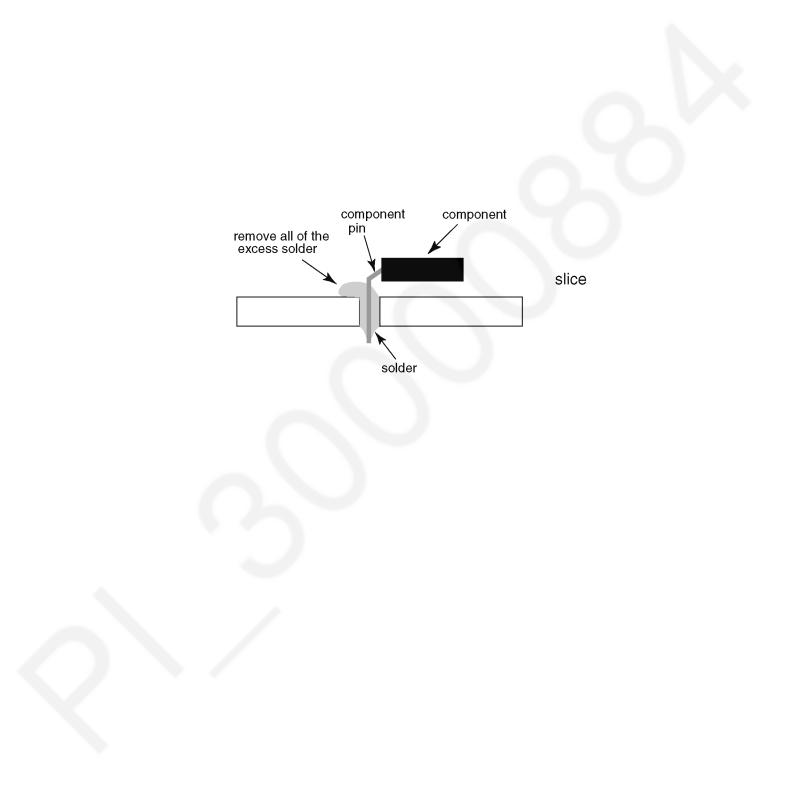
TH-42CS510S
2.2.About lead free solder (PbF)
Note: Lead is listed as (Pb) in the periodic table of elements.
In the information below, Pb will refer to Lead solder, and PbF will refer to Lead Free Solder. The Lead Free Solder used in our manufacturing process and discussed below is (Sn+Ag+Cu). That is Tin (Sn), Silver (Ag) and Copper (Cu) although other types are available.
This model uses Pb Free solder in it’s manufacture due to environmental conservation issues. For service and repair work, we’d suggest the use of Pb free solder as well, although Pb solder may be used.
PCBs manufactured using lead free solder will have the PbF within a leaf Symbol PbF stamped on the back of PCB.
Caution
•Pb free solder has a higher melting point than standard solder. Typically the melting point is 50 ~ 70 °F (30~40 °C) higher. Please use a high temperature soldering iron and set it to 700 ± 20 °F (370 ± 10 °C).
•Pb free solder will tend to splash when heated too high (about 1100 °F or 600 °C).
If you must use Pb solder, please completely remove all of the Pb free solder on the pins or solder area before applying Pb solder. If this is not practical, be sure to heat the Pb free solder until it melts, before applying Pb solder.
•After applying PbF solder to double layered boards, please check the component side for excess solder which may flow onto the opposite side. (see figure below)
5

TH-42CS510S
3 Service Navigation
3.1.Service Hint
Board Name |
Main Device |
Remarks |
|
|
|
A BOARD |
TUN, OFDM, ADV, sLD8A, STBY EEP |
Repairable |
P BOARD |
Power Supply |
Repairable |
GK BOARD |
Function SW |
Repairable |
K BOARD |
LED/ RM/ CATS |
Repairable |
LD BOARD |
LED DRIVER |
Repairable |
|
|
|
6

TH-42CS510S
4 Specifications
Dimensions (W H D)
Mass
Power source
Rated power consumption Standby power consumption Visible screen size (diagonal) Display resolution
Panel
Sound
Speaker output Connection terminals
AV IN
(COMPONENT / VIDEO)
HDMI 1 / 2 input
ETHERNET
USB 1 / 2
DIGITAL AUDIO OUT Receiving systems / Band name
Receiving channels (Analogue TV) VHF BAND
UHF BAND
CATV
963 mm 610 mm 247 mm (With Pedestal) 963 mm 566 mm 69 mm (TV only)
10.0  Net (With Pedestal)
Net (With Pedestal)
8.5  Net (TV only)
Net (TV only)
AC 220-240 V, 50 / 60 Hz 92.0 W
0.20 W
106 cm
1 920 (W) 1 080 (H)
LED backlight Liquid Crystal Display
20 W (10 W + 10 W)
VIDEO |
RCA PIN Type 1 1.0 V[p-p] (75 ) |
|
AUDIO L - R |
RCA PIN Type 2 0.5 V[rms] |
|
Y |
1.0 V[p-p] (including synchronisation) |
|
PB/CB, PR/CR |
±0.35 V[p-p] |
|
TYPE A Connectors |
|
|
HDMI1: Content Type |
|
|
HDMI2: Content Type, Audio Return Channel |
|
|
• This TV supports ‘HDAVI Control 5’ function. |
|
|
10BASE-T/100 BASE-TX |
|
|
DC 5 V, Max. 500 mA [Hi-Speed USB (USB 2.0)] |
|
|
PCM / Dolby Digital / DTS, Fibre optic |
|
|
|
17 SYSTEMS |
FUNCTION |
1PAL B, G, H
2PAL I
3 |
PAL D, K |
Reception of broadcast transmissions and |
|
4 |
SECAM B, G |
||
Playback from Video Cassette Tape Recorders |
|||
5 |
SECAM D, K |
||
|
|||
6 |
SECAM K1 |
|
|
7 |
NTSC M (NTSC 3.58 / 4.5 MHz) |
|
|
|
|
|
|
8 |
NTSC 4.43 / 5.5 MHz |
|
|
9 |
NTSC 4.43 / 6.0 MHz |
|
|
10 |
NTSC 4.43 / 6.5 MHz |
Playback from Special VCR’s or DVD |
|
11 |
NTSC 3.58 / 5.5 MHz |
12NTSC 3.58 / 6.0 MHz
13NTSC 3.58 / 6.5 MHz
14SECAM I
|
15 |
PAL 60 Hz / 5.5 MHz |
Playback from Special Disc Players and |
|
16 |
PAL 60 Hz / 6.0 MHz |
|
|
Special VCR’s or DVD |
||
|
17 |
PAL 60 Hz / 6.5 MHz |
|
|
|
||
|
|
|
|
Digital TV |
|
7 MHz VHF / 8 MHz UHF free-to-air TV broadcast reception |
|
2 |
- 12 |
(PAL / SECAM B, K1) |
|
0 |
- 12 |
(PAL B AUST.) |
|
|
1 - 9 |
(PAL B N.Z.) |
|
1 |
- 12 |
(PAL / SECAM D) |
|
1 |
- 12 |
(NTSC M Japan) |
|
2 |
- 13 |
(NTSC M USA) |
|
21 |
- 69 |
(PAL G, H, I / SECAM G, K, K1) |
|
28 |
- 69 |
(PAL B AUST.) |
|
13 |
- 57 |
(PAL D, K) |
|
13 |
- 62 |
(NTSC M Japan) |
|
14 |
- 69 |
(NTSC M USA) |
|
S1 - S20 |
(OSCAR) |
|
|
1 - 125 |
(USA CATV) |
|
|
C13 - C49 |
(JAPAN) |
|
|
S21 - S41 |
(HYPER) |
|
|
Z1 - Z37 |
(CHINA) |
|
|
5A, 9A |
(AUST.) |
|
|
7

TH-42CS510S
Aerial input |
VHF / UHF |
|
Operating Conditions |
Temperature |
0°C - 35°C |
|
Humidity |
20 % - 80 % RH (non-condensing) |
Built-in wireless LAN |
Standard compliance and Frequency range* |
|
|
IEEE802.11a/n |
|
|
5.15 GHz -5.35 GHz, 5.47 GHz -5.85 GHz |
|
|
IEEE802.11b/g/n |
|
|
2.40 GHz -2.4835 GHz |
|
|
Security |
|
|
WPA2-PSK (TKIP/AES) |
|
|
WPA-PSK (TKIP/AES) |
|
|
WEP (64 bit/128 bit) |
|
* The frequency and channel differ depending on the country.
Note
•Design and Specifications are subject to change without notice. Mass and Dimensions shown are approximate.
•For the information of the open source software, refer to [eHELP] (Support > Licence).
8
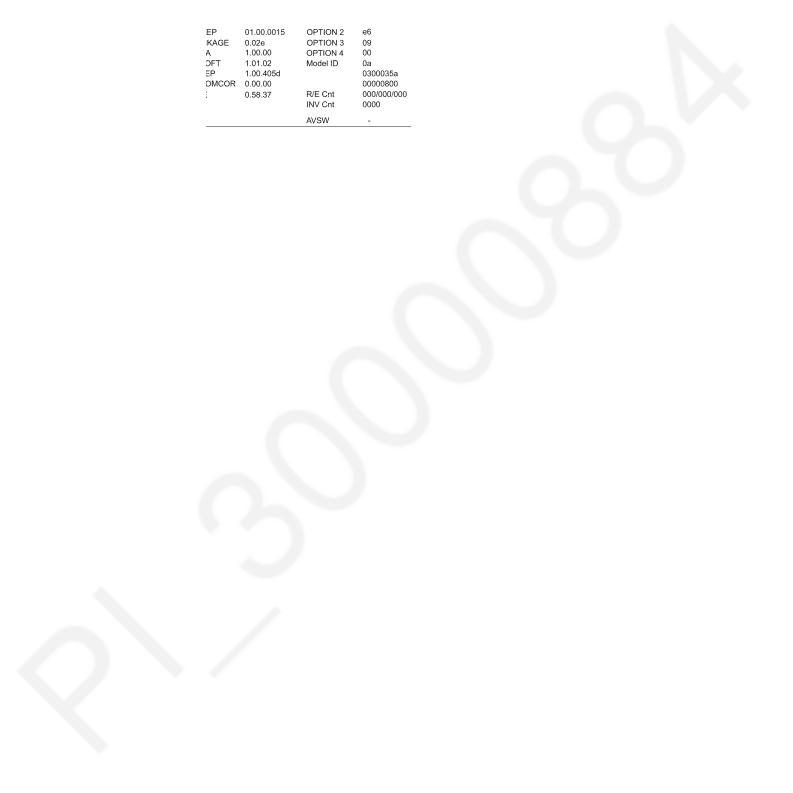
TH-42CS510S
5 Service Mode
5.1.How to enter into Service Mode
5.1.1.Purpose
After exchange parts, check and adjust the contents of adjustment mode.
While pressing [VOLUME ( - )] button of the main unit, press [INFO] button of the remote control three times within 2 seconds.
5.1.2.Key command
[1]button...Main items Selection in forward direction
[2]button...Main items Selection in reverse direction
[3]button...Sub items Selection in forward direction
[4]button...Sub items Selection in reverse direction
[VOL] button...Value of sub items change in forward direction ( + ), in reverse direction ( - )
5.1.3.How to exit
Switch off the power with the [POWER] button on the main unit or the [POWER] button on the remote control.
5.1.4.Contents of adjustment mode
•Value is shown as a hexadecimal number.
•Preset value differs depending on models.
•After entering the adjustment mode, take note of the value in each item before starting adjustment.
Main item |
Sub item |
Sample Data |
|
|
|
ADJUST |
CONTRAST |
|
|
|
|
|
COLOUR |
|
|
|
|
|
TINT |
|
|
|
|
|
SUB-BRT |
|
|
|
|
|
BACKLGT |
|
|
|
|
|
H POS |
|
|
|
|
|
H AMP |
|
|
|
|
|
V POS |
|
|
|
|
|
V AMP |
|
|
|
|
|
A COM |
|
|
|
|
WB-ADJ |
R-GAIN |
8D |
|
|
|
|
G-GAIN |
AE |
|
|
|
|
B-GAIN |
FF |
|
|
|
|
R-CENT |
6C |
|
|
|
|
G-RENT |
80 |
|
|
|
|
B-CENT |
A0 |
|
|
|
9

TH-42CS510S
Main item |
Sub item |
Sample Data |
|
|
|
OPTION |
Boot |
ROM |
|
|
|
|
STBY-SET |
00 |
|
|
|
|
EMERGENCY |
ON |
|
|
|
|
CLK MODE |
00 |
|
|
|
|
CLOCK |
FC7 |
|
|
|
|
Y/C DELAY |
DYNAMIC |
|
|
|
|
OPT 1 |
00000000 |
|
|
|
|
OPT 2 |
11100110 |
|
|
|
|
OPT 3 |
00001001 |
|
|
|
|
OPT 4 |
00000000 |
|
|
|
|
EDID-CLK |
HIGH |
|
|
|
SRV-TOOL |
|
00 |
|
|
|
DRV CHECK |
|
DYNAMIC |
|
|
|
5.1.5.Display of SOS History
SOS History (Number of LED blinking) indication.
From left side; Last SOS, before Last, three occurrence before, 2nd occurrence after shipment, 1st occurrence after shipment. This indication except 2nd and 1st occurrence after shipment will be cleared by [Self-check indication and forced to factory shipment setting].
5.1.6.Exit
1. Disconnect the AC cord from wall outlet.
10

5.1.7.Hotel Mode
1.Purpose
Restrict a function for hotels.
2.Access command to the Hotel mode setup menu. In order to display the Hotel mode setup menu:
While pressing [VOLUME (-)] button of the main unit, press [AV] button of the remote control three times within 2 seconds.
Then, the Hotel mode setup menu is displayed.
3.To exit the Hotel mode setup menu Disconnect AC power cord from wall outlet.
4.Explain the Hotel mode setup menu
TH-42CS510S
Item |
Function |
Hotel Mode |
Select hotel mode On/Off |
Initial INPUT |
Select input signal modes. |
|
Set the input, when each time power is switched on. |
|
Selection : |
|
Off,Analogue,DVB-C,DVB-T,AV1,AV2,HDMI1, |
|
HDMI2 |
|
• Off: give priority to a last memory. However, Euro |
|
model is compulsorily set to TV. |
|
|
Initial POS |
Select programme number. |
|
Selection : |
|
Off/0 to 99 |
|
• Off: give priority to a last memory. |
|
|
Initial VOL LEVEL |
Adjust the volume when each time power is switched |
|
on. |
|
Selection Range : |
|
Off/0 to 100 |
|
• Off: give priority to a last memory. |
|
|
Maximum Vol Level |
Adjust maximum volume. |
|
Range : |
|
0 to 100 |
|
|
Button Lock |
Select local key conditions. |
|
Selection : |
|
Off/SETUP/MENU/ALL |
|
• OFF: altogether valid |
|
• SETUP: only F-key is invalid |
|
(Tuning guide (menu) can not be selected.) |
|
• MENU: only F-key is invalid |
|
(only Volume/Mute can be selected.) |
|
• ALL: altogether invalid. |
|
|
Remote Lock |
Select remote control key conditions. |
|
Selection : |
|
Off/SETUP/MENU |
|
• OFF: altogether valid. |
|
• SETUP: only Setup menu is invalid. |
|
• MENU: Picture/Sound/Setup menu are invalid. |
|
|
Hotel Mode USB |
Basically after user already setup the hotel mode |
|
according to their criteria, what they need to do is |
|
• insert USB (while in hotel mode) |
|
• choose ‘Copy TV to USB’ to copy the setting into |
|
the USB (a file will be created to store the hotel |
|
mode setting in the USB) |
|
• switch ‘OFF’ the unit |
|
• pull out USB from unit |
|
To copy the hotel mode setting from USB. |
|
• enter hotel mode |
|
• insert USB |
|
• choose ‘Copy USB to TV’ |
|
• follow instruction as shown on the units |
|
• once finish, switch ‘OFF; the unit |
|
• pull out USB from unit |
|
|
Private Information |
Select private information for VIERA Cast is Keep or |
|
Reset if Hotel mode is set to [On] when TV power on |
|
Selection : |
|
Keep/Reset |
|
• Keep: private information for VIERA Cast is keep |
|
• Reset: private information for VIERA Cast is |
|
reset |
|
|
11

TH-42CS510S
6 Troubleshooting Guide
Use the self-check function to test the unit.
1.Checking the IIC bus lines
2.Power LED Blinking timing
6.1.Check of the IIC bus lines
6.1.1.How to access
6.1.2.Self-check indication only
Produce TV reception screen, and while pressing [VOLUME ( - )] button on the main unit, press [OK] button on the remote control for more than 3 seconds.
6.1.3.Self-check indication and forced to factory shipment setting
Produce TV reception screen, and while pressing [VOLUME ( - )] button on the main unit, press [MENU] button on the remote control for more than 3 seconds.
6.1.4.Exit
Disconnect the AC cord from wall outlet.
6.1.5.Screen display
12

TH-42CS510S
6.2.Power LED Blinking timing chart
1.Subject
Information of LED Flashing timing chart.
2.Contents
When an abnormality occurs, the protection circuit will operate and reset the unit to stand by mode. During this time, the defective block can be identified by the number of blinking times of the Power LED on the front panel of the unit as follow:
|
Priority SOS detection |
LED Blink |
|
|
|
1 |
BL_SOS |
1 |
|
|
|
2 |
SUB_3.3V |
7 |
|
|
|
3 |
SOUND_SOS |
9 |
|
|
|
4 |
SOS |
8 |
|
|
|
5 |
GCX/FRC_SOS |
10 |
|
|
|
6 |
BE(sLD8/PRO4) SOS |
12 |
|
|
|
7 |
Emergency SOS |
13 |
|
|
|
8 |
IROM-SOS |
3 |
|
|
|
6.3.Method of detecting SOS
1.BL_SOS
Detection beginning after one second pass from ‘BL_ON’=ON
2.TV_SOS
Detection beginning after one second pass from ‘AMP_SHUTDOWN’=ON
3.SOUND_SOS
Detection beginning ‘AMP_SHUTDOWN’=ON
13

TH-42CS510S
6.4.LCD Panel test mode
Purpose:
To find the possible failure point where in LCD Panel or Printed Circuit Board when the abnormal picture is displayed.
How to Enter:
While pressing [VOLUME ( - )] button of the main unit, press [OPTION] button of the remote control three times within 2 seconds.
How to Exit:
Disconnect AC plug from wall outlet.
How to confirm:
If the abnormal picture is displayed, go into LCD Panel test mode to display the several test patterns. And then, judge by the following method.
Still abnormal picture is displayed: The cause must be in LCD Panel. Normal picture is displayed: The cause must be in A board.
Remarks:
The test pattern is created by the circuit in LCD Panel.
In LCD Panel test mode, this test pattern is displayed unaffected by signal processing for RF or input signal. If the normal picture is displayed, LCD Panel must be okay and the cause of failure must be in A board.
6.5.No Power
First check point
There are following 2 states of No Power indication by power LED.
1.No lit
2.Red is lit then turns red blinking a few seconds later. (See 6.2.)
14
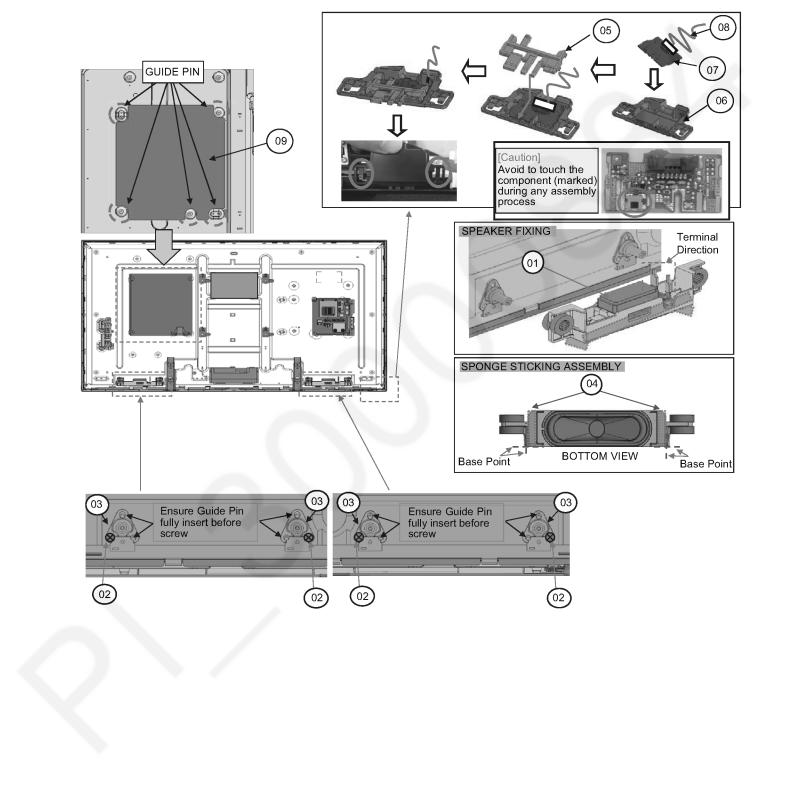
TH-42CS510S
7 Disassembly and Assembly Instructions
7.1.Speaker Assy
Install the two SP UNIT into SP bracket.
No |
Description |
Qty |
UOM |
Ref. Type |
01 |
SPEAKER UNIT |
2 |
PC |
|
|
|
|
|
|
02 |
SCREW(A3/P5/LBRD4) |
4 |
PC |
6 ± 1 kgf.cm |
|
|
|
|
|
03 |
SP BRACKET |
4 |
PC |
|
|
|
|
|
|
04 |
SP. SPONGE |
4 |
PC |
|
|
|
|
|
|
05 |
LED PANEL |
1 |
PC |
|
|
|
|
|
|
06 |
LED PANEL CASE |
1 |
PC |
|
|
|
|
|
|
07 |
K PRINT |
1 |
PC |
|
|
|
|
|
|
08 |
WIRE(A10-K10) |
1 |
PC |
|
|
|
|
|
|
09 |
BARRIER |
1 |
PC |
|
|
|
|
|
|
15
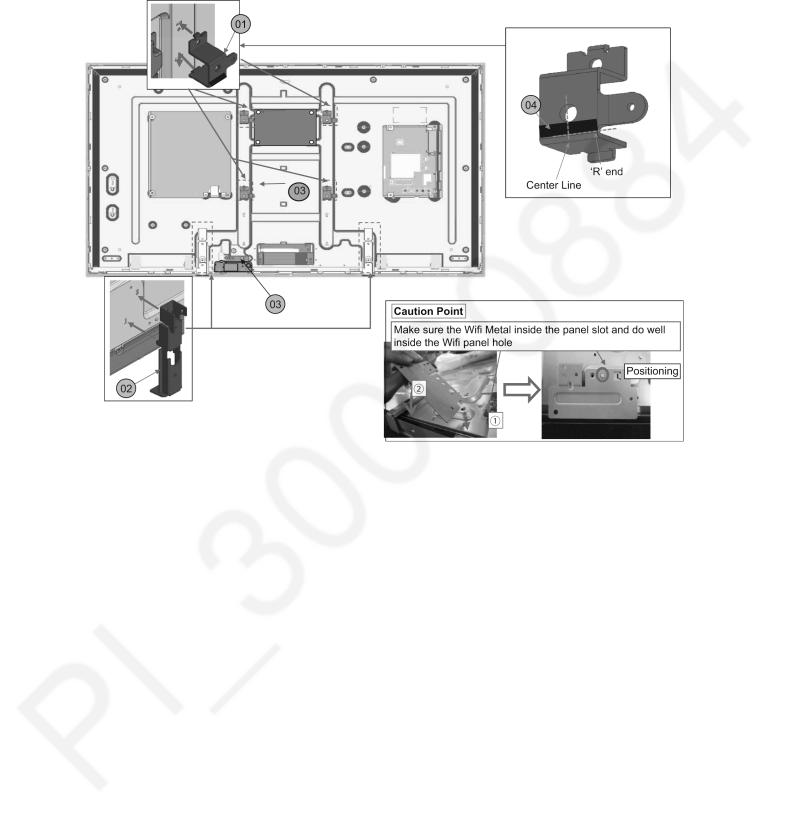
TH-42CS510S
7.2.Metal MTG Fixing
Fix vesa metal and bottom panel into panel and screw.
No |
Description |
Qty |
UOM |
01 |
VESA METAL |
4 |
PC |
|
|
|
|
02 |
BOTTOM METAL |
2 |
PC |
|
|
|
|
03 |
WIFI_METAL |
1 |
PC |
|
|
|
|
04 |
FELT (5 15 0.35t) |
4 |
PC |
|
|
|
|
16
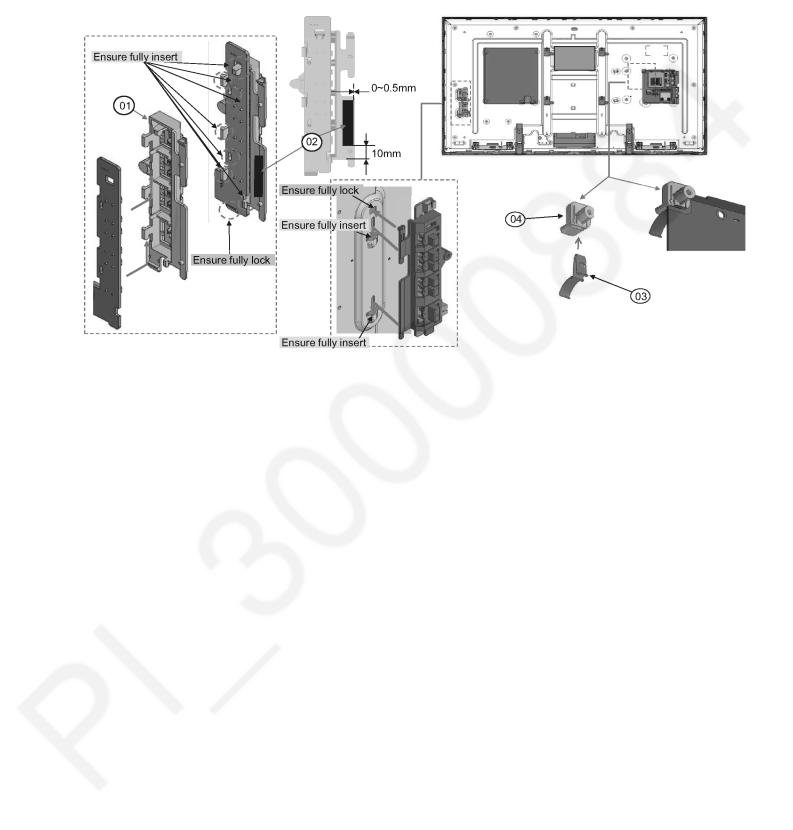
TH-42CS510S
7.3.Key Button Assembly
Fix pcb at key button bracket and fix at panel.
No |
Description |
Qty |
UOM |
01 |
KEY BUTTON BRACKET |
1 |
PC |
|
|
|
|
02 |
FELT (10 35 0.35t) |
1 |
PC |
|
|
|
|
03 |
GROUND SPRING |
1 |
PC |
|
|
|
|
04 |
CHASSIS BRACKET A-PCB |
1 |
PC |
|
|
|
|
17
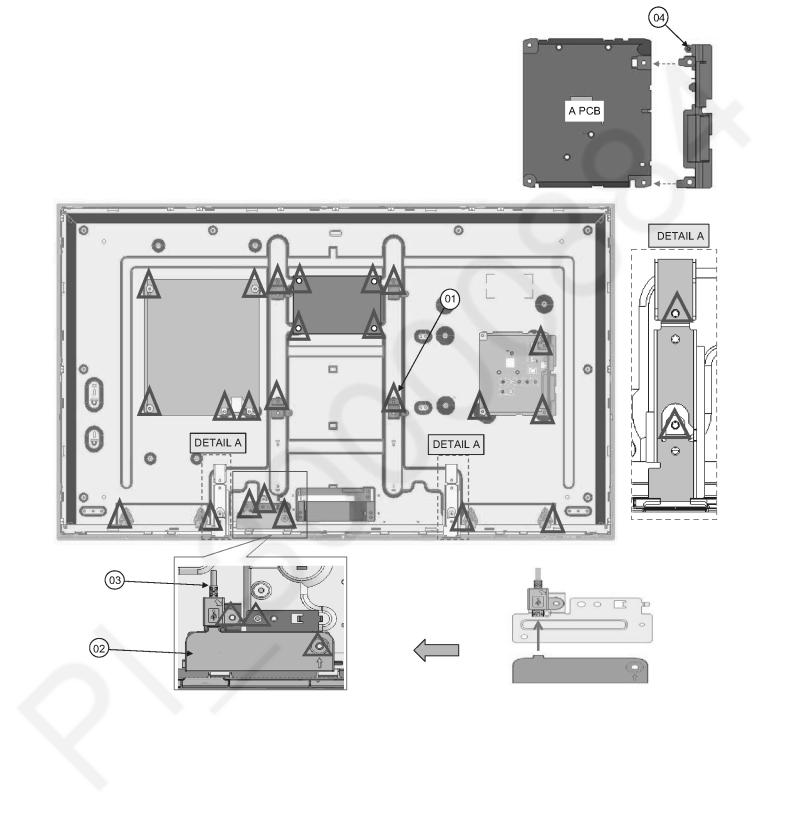
TH-42CS510S
7.4.Screw Assembly
Screwing.
No |
Description |
Qty |
UOM |
Ref. Type |
01 |
SCREW(A3/P5/VESA4/MTL4/LBRD4/SP4/WIFI3) |
27 |
PC |
6 ± 1 kgf.cm |
|
|
|
|
|
02 |
WIFI MODULE |
1 |
PC |
|
|
|
|
|
|
03 |
WIFI DONGLE WIRE |
1 |
PC |
|
|
|
|
|
|
04 |
SIDE AV BRACKET |
1 |
PC |
|
|
|
|
|
|
18
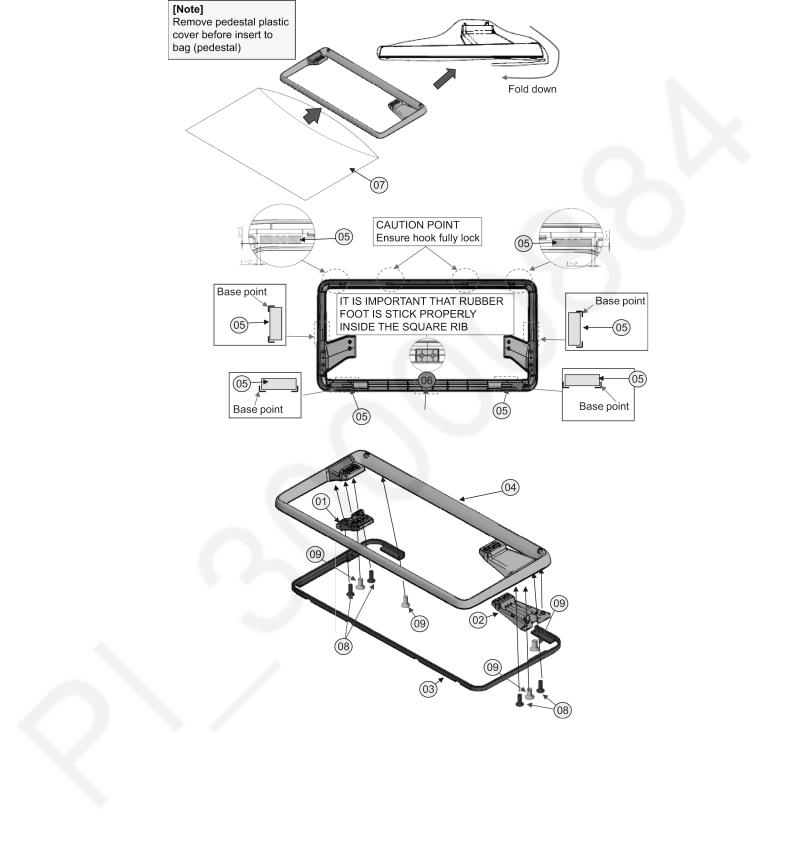
TH-42CS510S
7.5.Pedestal Assembly
Fix pedestal follow below, need screw first before stick rubber foot.
No |
Description |
Qty |
UOM |
01 |
NECK BASE L |
1 |
PC |
|
|
|
|
02 |
NECK BASE R |
1 |
PC |
|
|
|
|
03 |
METAL FRAME |
1 |
PC |
|
|
|
|
04 |
BASE COVER |
1 |
PC |
|
|
|
|
05 |
RUBBER FOOT |
6 |
PC |
|
|
|
|
06 |
RUBBER FOOT |
1 |
PC |
|
|
|
|
07 |
BAG (PEDESTAL) |
1 |
PC |
|
|
|
|
08 |
M4 12 FLAT HEADSCREW |
4 |
PC |
|
|
|
|
09 |
M4 10_FLAT_HEAD_SCREW (BLACK) |
4 |
PC |
|
|
|
|
19
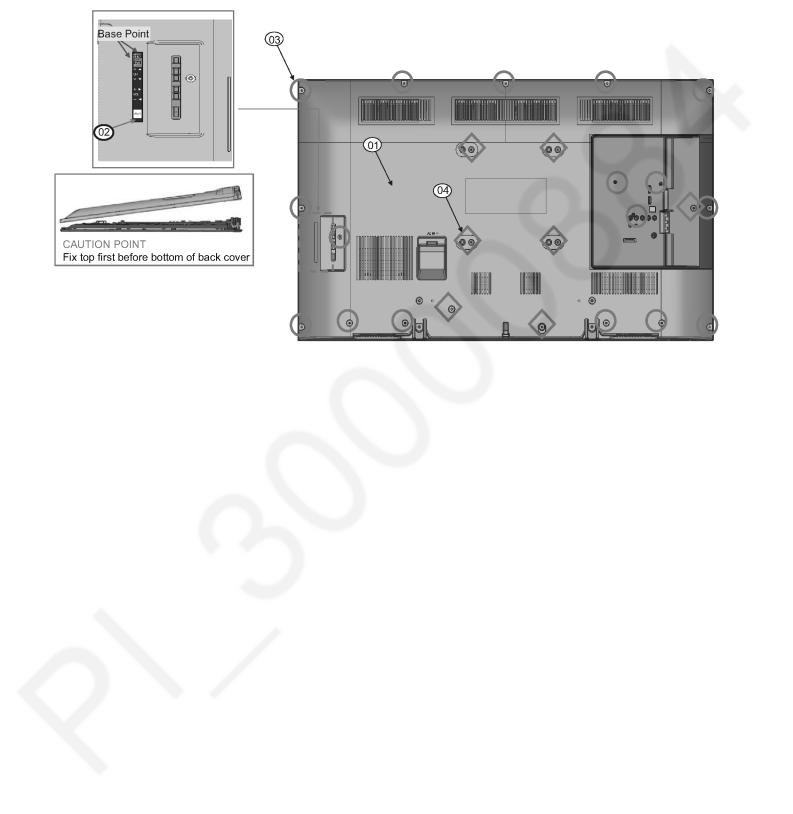
TH-42CS510S
7.6.Back Cover - Screw & Label
1.Fix back cover and screw.
2.Stick side button label, model name plate and serial number label.
No |
Description |
Qty |
UOM |
Ref. Type |
01 |
BACK_COVER |
1 |
PC |
|
|
|
|
|
|
02 |
SIDE BUTTON LABEL |
1 |
PC |
|
|
|
|
|
|
03 |
SCREW(BC9/AV3/CRTL1/SP4) |
17 |
PC |
6 ± 1 Kgf.cm |
|
|
|
|
|
04 |
SCREW(BC3/VESA4) |
7 |
PC |
6 ± 1 Kgf.cm |
|
|
|
|
|
20
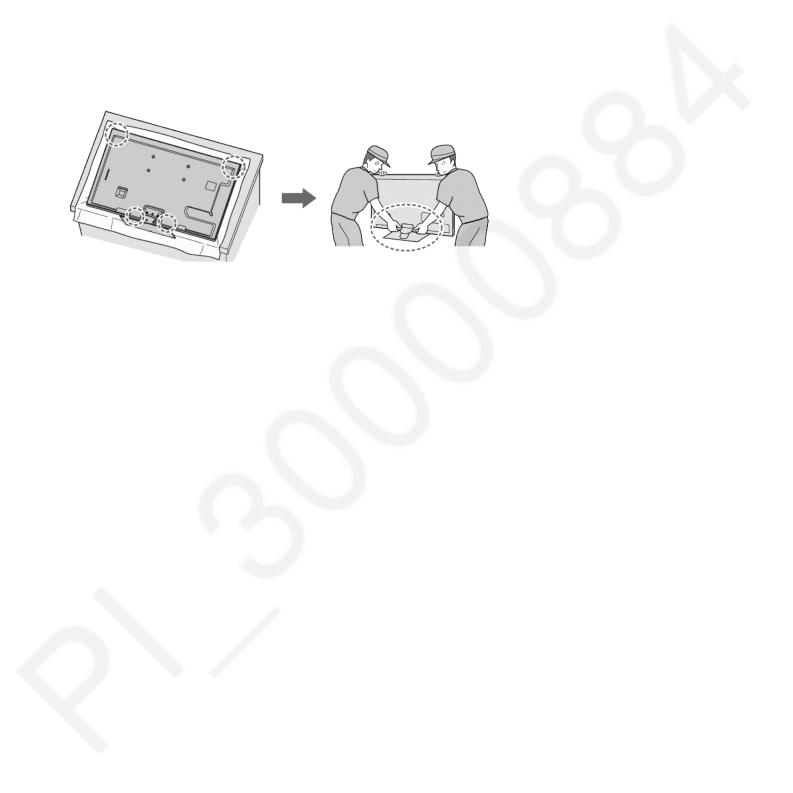
TH-42CS510S
7.7.Handling SPEC
■ Moving the LCD module
The module should be handle by two people and hold on that top and bottom long side by both hands without module warping. Never handle the module with keeping horizontal position when moving the module in order to avoid internal damage and deformation. Never drop or hit the module.
■ About the work table
When tightening a screw, retention structures are required not to deform the LCD module. ■ Moving the TV (Case with a stand)
Hold the specified parts as shown to stand the TV up and move it with two people.
21

TH-42CS510S
8 Measurements and Adjustments
8.1.Voltage chart of A-board
Set A-Board to a dummy set and check the satisfaction with the specified voltage as following table.
Power Supply Name |
Measurement Point |
Specification |
|
|
|
|
|
PANEL12V |
TP4097 |
11.3V - 13V |
|
|
|
|
|
SUB3.3V |
TP5400 |
3.16V |
- 3.48V |
|
|
|
|
SUB5V |
TP5420 |
4.98V |
- 5.25V |
|
|
|
|
SUB1.5V |
TP8101 |
1.45V |
- 1.57V |
|
|
|
|
SUB1.1V |
TP8100 |
1.14V |
- 1.26V |
|
|
|
|
STB5V |
TP5200 |
4.9V |
- 5.4V |
|
|
|
|
STB3.3V |
TP5002 |
3.14V |
- 3.46V |
|
|
|
|
HDMI3.3V |
TP8000 |
3.14V |
- 3.46V |
|
|
|
|
8.2.Voltage chart of P-board
Set P-Board to a dummy load and check the satisfaction with the specified voltage as following table.
Output |
Test Point |
|
Specification |
|
|
|
|
||
Step 1 |
|
Step 2 |
||
|
|
|
||
|
|
|
|
|
24V |
TP7407 |
<1V |
|
32 ± 1.6V |
|
|
|
|
|
16V |
TP7410 |
<1V |
|
15.7 ± 0.8V |
|
|
|
|
|
5VS |
TP7501 |
5.2 ± 0.2V |
|
5.2 ± 0.2V |
|
|
|
|
|
PFC |
TP7201 or TP7202 |
<340V |
|
390V ± 15V |
|
|
|
|
|
Step 1 JK7101 - AC100V/230V OFF.
Supply AC 100V/230 to JK7101 connector in the P-Board. Main power button is OFF.
Step 2 TV_SUB_ON P2 connector - pin 8 (TP7416) DC2.5V ON.
Supply DC 2.5V to TV_SUB_ON P2 connector - pin 8 (TP7416), displayed as SWITCH.
NOTE : GND REFERENCE TP7413/TP7414/TP7415/TP7515/TP7516/TP7517 (COLD SIDE)
22
